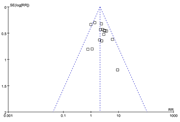Serum KL-6 and the mortality of patients with connective tissue disease-associated interstitial lung disease: A meta-analysis
DOI:
https://doi.org/10.17305/bb.2024.10368Keywords:
Interstitial lung disease (ILD), connective tissue disease (CTD), Krebs von den Lungen-6 (KL-6), mortality, meta-analysisAbstract
Connective tissue disease-associated interstitial lung disease (CTD-ILD) is an important underlying cause of morbidity and mortality in patients with CTD. Serum Krebs von den Lungen-6 (KL-6) is an immune factor which has been related to the severity of ILD. This systematic review and meta-analysis aimed to evaluate the association between serum KL-6 and mortality of patients with CTD-ILD. Longitudinal studies relevant to the aim of the meta-analysis were retrieved by search of electronic databases including PubMed, Web of Science, and Embase. A random-effects model was used to combine the data by incorporating the influence of between-study heterogeneity. Fifteen cohorts involving 1737 patients with CTD-ILD were included. During a mean follow-up of 35.3 months, 430 (24.8%) patients died. Compared to those with a lower KL-6 at admission, patients with a higher KL-6 were associated with a higher mortality risk during follow-up (risk ratio: 2.18, 95% confidence interval: 1.66 to 2.87, P < 0.001; I2 = 20%). Subgroup analysis showed a significant association in studies from Asian countries, but not in those from non-Asian countries; in studies with cutoff of KL-6 derived in receiver operating characteristic (ROC) curve analysis, but not in those derived from other methods; in studies with multivariate analysis, but not in those with univariate analysis (P for subgroup difference all < 0.05). The association was not significantly affected by different CTDs or methods for measuring serum KL-6. In conclusion, a high serum KL-6 may be a risk factor of increased mortality in patients with CTD-ILD.
Citations
Downloads

Downloads
Published
Issue
Section
Categories
License
Copyright (c) 2024 Mei Hong, Xue Yin, Wenmei Yan, Wei Guo, Hongmei Liu, Haisheng Yang

This work is licensed under a Creative Commons Attribution 4.0 International License.









